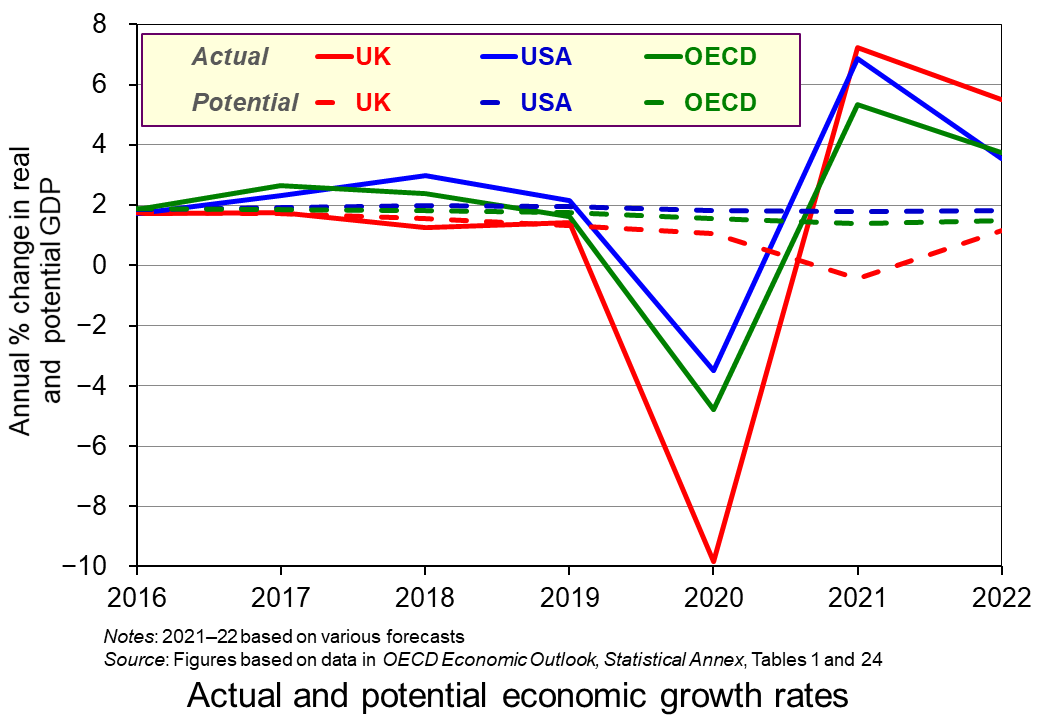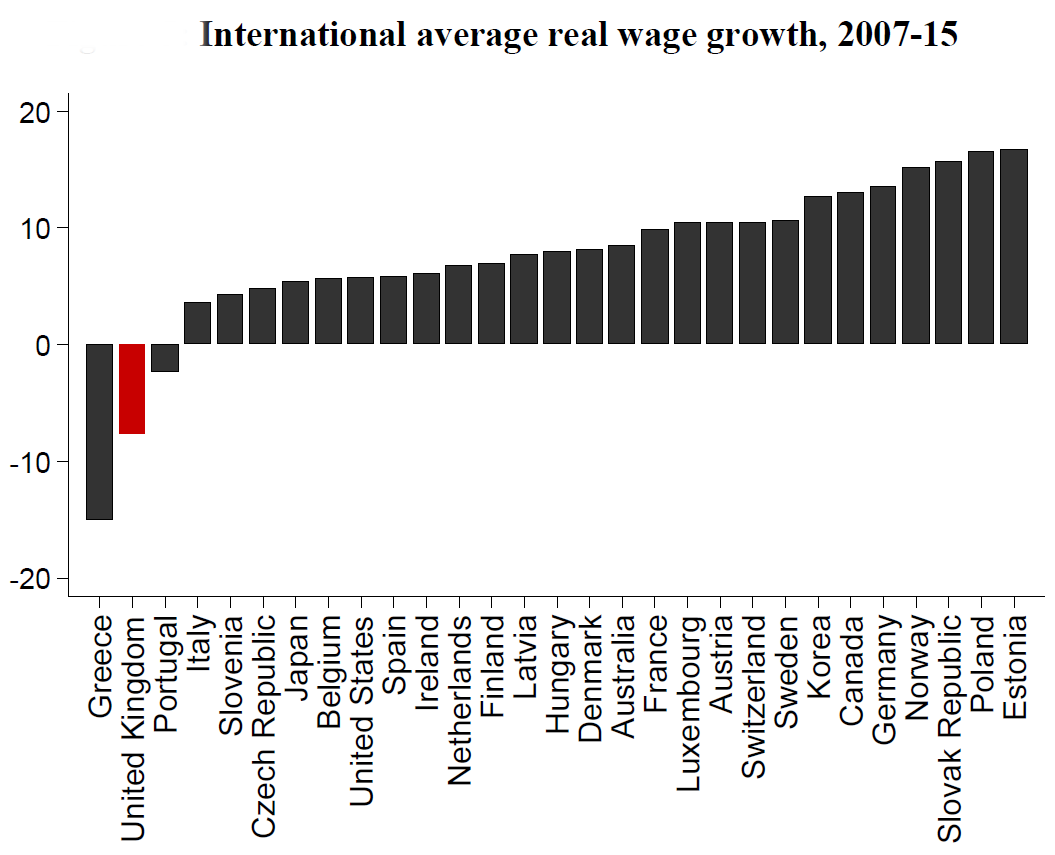 At a meeting of the G7 finance ministers in London from 4–5 June, it was agreed to adopt a minimum corporate tax rate of 15% and to take measures to prevent multinational companies using tax havens to avoid paying taxes. It was also agreed that part of the taxes paid should go to the countries where sales are made and not just to those where the companies are based.
At a meeting of the G7 finance ministers in London from 4–5 June, it was agreed to adopt a minimum corporate tax rate of 15% and to take measures to prevent multinational companies using tax havens to avoid paying taxes. It was also agreed that part of the taxes paid should go to the countries where sales are made and not just to those where the companies are based.
This agreement is the first step on the road to a comprehensive global agreement. The next step is a meeting of the finance ministers and central bank governors of the G20 countries in Venice from 9 to 10 July. The G7 ministers hope that their agreement will be adopted by this larger group, which includes other major economies such as Russia, China, India, Brazil, Australia, South Korea and South Africa.
Later in July, the proposals will be put to a group of 139 countries and jurisdictions at a meeting co-ordinated by the OECD. It is hoped that this meeting will finalise an international agreement with precise details on corporate tax rules. It follows work by the OECD on reforming international taxation under its Framework on Base Erosion and Profit Shifting (BEPS).
 These meetings follow growing concerns about the ability of multinational companies to avoid taxes by basing regional headquarters in low-tax countries, such as Luxembourg or Singapore, and declaring their profits there, despite having only a tiny proportion of their sales in these countries.
These meetings follow growing concerns about the ability of multinational companies to avoid taxes by basing regional headquarters in low-tax countries, such as Luxembourg or Singapore, and declaring their profits there, despite having only a tiny proportion of their sales in these countries.
The desire to attract multinational profits has led to a prisoners’ dilemma situation, whereby countries have been competing against each other to offer lower taxes, even though it reduces global corporate tax revenues.
With many countries having seen a significant rise in government deficits as result of the COVID-19 pandemic and the support measures put in place, there has been a greater urgency to reach international agreement on corporate taxes. The G7 agreement, if implemented, will provide a significant increase in tax revenue.
Details of the G7 agreement
The agreement has two parts or ‘pillars’.
Pillar 1 allows countries to tax large multinationals earning global profits of more than 10% if these companies are not based there but earn revenues there. Countries will be given tax rights over at least 20% of the profits earned there which exceed the 10% margin. The level of profits determined for each country will be based on the proportion of revenues earned there.
Pillar 2 sets a minimum corporate tax rate of 15% for each of the seven countries, which call on other countries to adopt the same minimum. The hope is that the G20 countries will agree to this and then at the OECD meeting in July a global agreement will be reached. If a country chooses to charge a rate below 15%, then a top-up tax can be applied by the home country to bring the total rate up to the 15%.
It is possible that these proposals will be strengthened/amended at the G20 and OECD meetings. For example, the 15% minimum rate may be raised. Indeed, the USA had initially proposed a 25% rate and then 21%, and several EU countries such as France, have been pushing for a substantially higher rate.
Analysis
The agreement was hailed as ‘historic’ by Rishi Sunak, the UK Chancellor of the Exchequer. This is true in that it is the first time there has been an international agreement on minimum corporate tax rates and locating part of tax liability according to sales. What is more, the rules may be strengthened at the G20 and/or OECD meetings.
There have been various criticisms of the agreement, however. The first is that 15% is too low and is well below the rates charged in many countries. As far as the UK is concerned, the IPPR think tank estimates that the deal will raise £7.9bn whereas a 25% rate would raise £14.7bn.
 Another criticism is that the reallocation of some tax liabilities to countries where sales are made rather than where profits are booked applies only to profits in excess of 10%. This would therefore not affect companies, such as Amazon, with a model of large-scale low-margin sales and hence profits of less than 10%.
Another criticism is that the reallocation of some tax liabilities to countries where sales are made rather than where profits are booked applies only to profits in excess of 10%. This would therefore not affect companies, such as Amazon, with a model of large-scale low-margin sales and hence profits of less than 10%.
Also there is the criticism that a 20% reallocation is too low and would thus provide too little tax revenue to poor countries which may record large sales but where little or no profits are booked.
 The UK was one of the more reluctant countries to sign up to a deal that would have a significant impact on tax havens in various British overseas territories and crown dependencies, such as the British Virgin islands, Bermuda, the Cayman Islands, the Channel Islands and Isle of Man. The agreement also calls into question whether the announced UK freeports can go ahead. Although these are largely concerned with waiving tariffs and other taxes on raw materials and parts imported into the freeport, which are then made into finished or semi-finished products within the freeport for export, they are still seen by many as not in the spirit of the G7 agreement.
The UK was one of the more reluctant countries to sign up to a deal that would have a significant impact on tax havens in various British overseas territories and crown dependencies, such as the British Virgin islands, Bermuda, the Cayman Islands, the Channel Islands and Isle of Man. The agreement also calls into question whether the announced UK freeports can go ahead. Although these are largely concerned with waiving tariffs and other taxes on raw materials and parts imported into the freeport, which are then made into finished or semi-finished products within the freeport for export, they are still seen by many as not in the spirit of the G7 agreement.
What is more, the UK has been pushing for financial services to be exempted from Pillar 1 of the deal, which would otherwise see taxes partly diverted from the UK to other countries where such firms do business. For example, HSBC generates more than half its income from China and Standard Chartered operates mostly in Asia and Africa.
Update: July 2021
The G7 plan was agreed by the finance ministers of the G20 countries on July 11 in Venice. By that point, 130 of the 139 countries which are part of the Inclusive Framework of the OECD and which represent more than 90% of global GDP, had signed up to the plan and it was expected that there would be a global agreement reached at the OECD meeting later in the month. The other nine countries were Ireland, Hungary and Estonia in the EU and Kenya, Nigeria, Peru, Sri Lanka, Barbados and Saint Vincent and the Grenadines. Several of these countries use low corporate taxes to encourage inward investment and are seen as tax havens.
Videos
Articles
- G-7 nations reach historic deal on global tax reform
CNBC, Silvia Amaro, Joanna Tan and Emma Newburger (5/6/21)
- Rishi Sunak hails ‘historic’ breakthrough as G7 ministers agree global tech tax deal
The Telegraph, Lucy Burton and Edward Malnick (5/6/21)
- G7 backs Biden’s sweeping overhaul of global tax system
CNN, Tara John and Kevin Liptak (5/6/21)
- ‘Historic’ G7 deal to stop global corporate tax avoidance welcomed by tech giants Google and Facebook
Sky News, Ajay Nair (6/6/21)
- Finance Leaders Reach Global Tax Deal Aimed at Ending Profit Shifting
New York Times, Alan Rappeport (5/6/21)
- G7 strikes historic agreement on taxing multinationals
Financial Times, Chris Giles (5/6/21)
- G7 tax deal is ‘starting point’ on road to global reform
LAPM Journal, Chris Giles and Delphine Strauss (FT) (6/6/21)
- G7 tax deal doesn’t go far enough, campaigners say
BBC News (6/6/21)
- Rishi Sunak announces ‘historic agreement’ by G7 on tax reform
The Observer, Phillip Inman and Michael Savage (5/6/21)
- G7 deal is as much about balance of power as global tax reform
The Guardian, Richard Partington (6/6/21)
- Global G7 deal may let Amazon off hook on tax, say experts
The Guardian, Jasper Jolly (6/6/21)
- Explainer: G7 tax deal – what was agreed and what does it mean for Ireland?
The Irish Times, Cliff Taylor (5/6/21)
- G7 deal: UK is badly conflicted between offshore tax havens and Biden’s global tax drive
The Conversation, Atul K. Shah (4/6/21)
- G7 tax dodging deal ‘sets bar so low companies can just step over it’
Independent, Emily Goddard (6/6/21)
- UK pushes for City of London to be exempt from G7 tax plan
The Guardian, Phillip Inman and Richard Partington (9/6/21)
- The global pandemic, sustainable economic recovery, and international taxation
Independent Commission for the Reform of International Corporate Taxation (May 2020)
- G20 finance ministers back deal to tax companies
BBC News (11/7/21)
Questions
- How are multinationals currently able to avoid paying corporate taxes in many countries, even though their sales may be high there?
- If the deal is accepted at the OECD meeting in July, would it still be in the interests of low-tax countries to charge tax rates below the agreed minimum rate?
- Why was the UK reluctant to accept the 21% rate proposed by the Biden administration?
- Find out about the digital services tax that has been adopted by many countries, including EU countries and the UK, and why it will be abolished once a minimum corporate tax comes into force.
- Argue the case for and against taxing the whole of multinational profits in countries where they earn revenue in proportion to the company’s total global revenue. Would such a system benefit developing countries?
- Should financial services, such as those provided by City of London firms, be exempted from the deal?
 The OECD has recently published its six-monthly Economic Outlook. This assesses the global economic situation and the prospects for the 38 members of the OECD.
The OECD has recently published its six-monthly Economic Outlook. This assesses the global economic situation and the prospects for the 38 members of the OECD.
It forecasts that the UK economy will bounce back strongly from the deep recession of 2020, when the economy contracted by 9.8 per cent. This contraction was deeper than in most countries, with the USA contracting by 3.5 per cent, Germany by 5.1 per cent, France by 8.2 per cent, Japan by 4.7 per cent and the OECD as a whole by 4.8 per cent. But, with the success of the vaccine roll-out, UK growth in 2021 is forecast by the OECD to be 7.2 per cent, which is higher than in most other countries. The USA is forecast to grow by 6.8 per cent, Germany by 3.3 per cent, France by 5.8 per cent, Japan by 2.6 per cent and the OECD as a whole by 5.3 per cent. Table 1 in the Statistical Annex gives the figures.
This good news for the UK, however, is tempered by some worrying features.
 The OECD forecasts that potential economic growth will be negative in 2021, with capacity declining by 0.4 per cent. Only two other OECD countries, Italy and Greece, are forecast to have negative potential economic growth (see Table 24 in the Statistical Annex). A rapid increase in aggregate demand, accompanied by a decline in aggregate supply, could result in inflationary pressures, even if initially there is considerable slack in some parts of the economy.
The OECD forecasts that potential economic growth will be negative in 2021, with capacity declining by 0.4 per cent. Only two other OECD countries, Italy and Greece, are forecast to have negative potential economic growth (see Table 24 in the Statistical Annex). A rapid increase in aggregate demand, accompanied by a decline in aggregate supply, could result in inflationary pressures, even if initially there is considerable slack in some parts of the economy.
Part of the reason for the supply constraints are the additional barriers to trade with the EU resulting from Brexit. The extra paperwork for exporters has added to export costs, and rules-of-origin regulations add tariffs to many exports to the EU (see the blog A free-trade deal? Not really). Another supply constraint linked to Brexit is the shortage of labour in certain sectors, such as hospitality, construction and transport. With many EU citizens having left the UK and not being replaced by equivalent numbers of new immigrants, the problem is likely to persist.
 The scarring effects of the pandemic present another problem. There has been a decline in investment. Even if this is only temporary, it will have a long-term impact on capacity, unless there is a compensating rise in investment in the future. Many businesses have closed and will not re-open, including many High Street stores. Moves to working from home, even if partially reversed as the economy unlocks, will have effects on the public transport industry. Also, people may have found new patterns of consumption, such as making more things for themselves rather than buying them, which could affect many industries. It is too early to predict the extent of these scarring effects and how permanent they will be, but they could have a dampening effect on certain sectors.
The scarring effects of the pandemic present another problem. There has been a decline in investment. Even if this is only temporary, it will have a long-term impact on capacity, unless there is a compensating rise in investment in the future. Many businesses have closed and will not re-open, including many High Street stores. Moves to working from home, even if partially reversed as the economy unlocks, will have effects on the public transport industry. Also, people may have found new patterns of consumption, such as making more things for themselves rather than buying them, which could affect many industries. It is too early to predict the extent of these scarring effects and how permanent they will be, but they could have a dampening effect on certain sectors.
Inflation
So will inflation take off, or will it remain subdued? At first sight it would seem that inflation is set to rise significantly. Annual CPI inflation rose from 0.7 per cent in March 2021 to 1.5 per cent in April, with the CPI rising by 0.6 per cent in April alone. What is more, the housing market has seen a large rise in demand, with annual house price inflation reaching 10.2 per cent in March.
But these rises have been driven by some one-off events. As the economy began unlocking, so spending rose dramatically. While this may continue for a few months, it may not persist, as an initial rise in household spending may reflect pent-up demand and as the furlough scheme comes to an end in September.
 As far as as the housing market is concerned, the rise in demand has been fuelled by the stamp duty ‘holiday’ which exempts residential property purchase from Stamp Duty Land Tax for properties under £500 000 in England and Northern Ireland and £250 000 in Scotland and Wales (rather than the original £125 000 in England and Northern Ireland, £145 000 in Scotland and £180 000 in Wales). In England and Northern Ireland, this limit is due to reduce to £250 000 on 30 June and back to £125 000 on 30 September. In Scotland the holiday ended on 31 March and in Wales is due to end on 30 June. As these deadlines are passed, this should see a significant cooling of demand.
As far as as the housing market is concerned, the rise in demand has been fuelled by the stamp duty ‘holiday’ which exempts residential property purchase from Stamp Duty Land Tax for properties under £500 000 in England and Northern Ireland and £250 000 in Scotland and Wales (rather than the original £125 000 in England and Northern Ireland, £145 000 in Scotland and £180 000 in Wales). In England and Northern Ireland, this limit is due to reduce to £250 000 on 30 June and back to £125 000 on 30 September. In Scotland the holiday ended on 31 March and in Wales is due to end on 30 June. As these deadlines are passed, this should see a significant cooling of demand.
Finally, although the gap between potential and actual output is narrowing, there is still a gap. According to the OECD (Table 12) the output gap in 2021 is forecast to be −4.6 per cent. Although it was −11.4 per cent in 2020, a gap of −4.6 per cent still represents a significant degree of slack in the economy.
At the current point in time, therefore, the Bank of England does not expect to have to raise interest rates in the immediate future. But it stands ready to do so if inflation does show signs of taking off.
Articles
- United Kingdom Economic Snapshot
OECD Economic Outlook (May 2021)
- UK growth forecast upgraded but pandemic economic ‘scar’ will be worst of all G7 nations, says OECD
Sky News, Ed Conway (31/5/21)
- OECD Predicts UK Economic Growth Amid Vaccine Success And Lockdown Easing
Minutehack Emma Bowden (1/6/21)
- UK growth upgraded, but OECD warns of deepest economic scar in G7
The Guardian, Graeme Wearden (31/5/21)
- UK set for stronger post-Covid recovery, says OECD
BBC News (31/5/21)
- British exports worth billions have faced EU tariffs since Brexit
BBC News, Faisal Islam (28/5/21)
 Post-Brexit: Businesses hit by labour shortages call for Brexit rules to be relaxed
Post-Brexit: Businesses hit by labour shortages call for Brexit rules to be relaxedChannel 4 News, Paul McNamara (2/6/21)
- Bank of England monitors UK housing boom as it weighs inflation risk
The Guardian, Larry Elliott (1/6/21)
- House prices jump 10.9% as ‘race for space’ intensifies
BBC News (1/6/21)
- Global food prices post biggest jump in decade
Financial Times, Emiko Terazono and Judith Evans (3/6/21)
- Why house prices are rising so fast in a pandemic
BBC News, Kevin Peachey and Daniele Palumbo (2/6/21)
- Inflation: why it could surge after the pandemic
The Conversation, Ian Crowther (23/4/21)
- Inflation might well keep rising in 2021 – but what happens after that?
The Conversation, Brigitte Granville (31/5/21)
- Slack in the Economy, Not Inflation, Should Be Bigger Worry
Institute for New Economic Thinking, Claudia Fontanari, Antonella Palumbo, and Chiara Salvatori (19/5/21)
Data, Forecasts and Analysis
Questions
- What determines the rate of (a) actual economic growth; (b) potential economic growth?
- What is meant by an output gap? What would be the implications of a positive output gap?
- Why are scarring effects of the pandemic likely to be greater in the UK than in most other countries?
- If people believed that inflation was likely to continue rising, how would this affect their behaviour and how would it affect the economy?
- What are the arguments for and against having a stamp duty holiday when the economy is in recession?
 In the last blog post, As UK inflation rises, so real wages begin to fall, we showed how the rise in inflation following the Brexit vote is causing real wages in the UK to fall once more, after a few months of modest rises, which were largely due to very low price inflation. But how does this compare with other OECD countries?
In the last blog post, As UK inflation rises, so real wages begin to fall, we showed how the rise in inflation following the Brexit vote is causing real wages in the UK to fall once more, after a few months of modest rises, which were largely due to very low price inflation. But how does this compare with other OECD countries?
In an article by Rui Costa and Stephen Machin from the LSE, the authors show how, from the start of the financial crisis in 2007 to 2015 (the latest year for which figures are available), real hourly wages fell further in the UK than in all the other 27 OECD countries, except Greece (see the chart below, which is Figure 5 from their article).  Indeed, only in Greece, the UK and Portugal were real wages lower in 2015 than in 2007.
Indeed, only in Greece, the UK and Portugal were real wages lower in 2015 than in 2007.
The authors examine a number of aspects of real wages in the UK, including the rise in self employment, differences by age and sex, and for different percentiles in the income distribution. They also look at how family incomes have suffered less than real wages, thanks to the tax and benefit system.
The authors also look at what the different political parties have been saying about the issues during their election campaigns and what they plan to do to address the problem of falling, or only slowly rising, real wages.
Articles
Real Wages and Living Standards in the UK LSE – Centre for Economic Performance, Rui Costa and Stephen Machin (May 2017)
The Return of Falling Real Wages LSE – Centre for Economic Performance, David Blanchflower, Rui Costa and Stephen Machin (May 2017)
The chart that shows UK workers have had the worst wage performance in the OECD except Greece Independent, Ben Chu (5/6/17)
Data
Earnings and working hours ONS
OECD.Stat OECD
International comparisons of productivity ONS
Questions
- Why have real wages fallen more in the UK than in all OECD countries except Greece?
- Which groups have seen the biggest fall in real wages? Explain why.
- What policies are proposed by the different parties for raising real wages (a) generally; (b) for the poorest workers?
- How has UK productivity growth compared with that in other developed countries? What explanations can you offer?
- What is the relationship between productivity growth and the growth in real wages?
 In an attempt to prevent recession following the financial crisis of 2007–8, many countries adopted both expansionary monetary policy and expansionary fiscal policy – and with some success. It is likely that the recession would have been much deeper without such policies
In an attempt to prevent recession following the financial crisis of 2007–8, many countries adopted both expansionary monetary policy and expansionary fiscal policy – and with some success. It is likely that the recession would have been much deeper without such policies
But with growing public-sector deficits caused by the higher government expenditure and sluggish growth in tax receipts, many governments soon abandoned expansionary fiscal policy and relied on a mix of loose monetary policy (with ultra low interest rates and quantitative easing) but tight fiscal policy in an attempt to claw down the deficits.
But such ‘austerity’ policies made it much harder for loose monetary policy to boost aggregate demand. The problem was made worse by the attempt of both banks and individuals to ‘repair’ their balance sheets. In other words banks became more cautious about lending, seeking to build up reserves; and many individuals sought to reduce their debts by cutting down on spending. Both consumer spending and investment were slow to grow.
And yet government and central banks, despite the arguments of Keynesians, were reluctant to abandon their reliance solely on monetary policy as a means of boosting aggregate demand. But gradually, influential international institutions, such as the IMF (see also) and World Bank, have been arguing for an easing of austerity fiscal policies.
 The latest international institution to take a distinctly more Keynesian stance has been the Organisation for Economic Co-operation and Development (OECD). In its November 2015 Economic Outlook it had advocated some use of public-sector investment (see What to do about slowing global growth?. But in its Interim Economic Outlook of February 2016, it goes much further. It argues that urgent action is needed to boost economic growth and that this should include co-ordinated fiscal policy. In introducing the report, Catherine L Mann, the OECD’s Chief Economist stated that:
The latest international institution to take a distinctly more Keynesian stance has been the Organisation for Economic Co-operation and Development (OECD). In its November 2015 Economic Outlook it had advocated some use of public-sector investment (see What to do about slowing global growth?. But in its Interim Economic Outlook of February 2016, it goes much further. It argues that urgent action is needed to boost economic growth and that this should include co-ordinated fiscal policy. In introducing the report, Catherine L Mann, the OECD’s Chief Economist stated that:
“Across the board there are lower interest rates, except for the United States. It allows the authorities to undertake a fiscal action at very very low cost. So we did an exercise of what this fiscal action might look like and how it can contribute to global growth, but also maintain fiscal sustainability, because this is an essential ingredient in the longer term as well.
 So we did an experiment of a two-year increase in public investment of half a percentage point of GDP per annum undertaken by all OECD countries. This is an important feature: it’s everybody doing it together – it’s a collective action, because it’s global growth that is at risk here – our downgrades [in growth forecasts] were across the board – they were not just centred on a couple of countries.
So we did an experiment of a two-year increase in public investment of half a percentage point of GDP per annum undertaken by all OECD countries. This is an important feature: it’s everybody doing it together – it’s a collective action, because it’s global growth that is at risk here – our downgrades [in growth forecasts] were across the board – they were not just centred on a couple of countries.
So what is the effect on GDP of a collective fiscal action of a half a percentage point of GDP [increase] in public investment in [high] quality projects. In the United States, the euro area, Canada and the UK, who are all contributors to this exercise, the increase in GDP is greater than the half percentage point [increase] in public expenditure that was undertaken. Even if other countries don’t undertake any fiscal expansion, they still get substantial increases in their growth rates…
Debt to GDP in fact falls. This is because the GDP effect of quality fiscal stimulus is significant enough to raise GDP (the denominator in the debt to GDP ratio), so that the overall fiscal sustainability [debt to GDP] improves.”
What is being argued is that co-ordinated fiscal policy targeted on high quality infrastructure spending will have a multiplier effect on GDP. What is more, the faster growth in GDP should outstrip the growth in government expenditure, thereby allowing debt/GDP ratios to fall, not rise.
This is a traditional Keynesian approach to tackling sluggish growth, but accompanied by a call for structural reforms to reduce inefficiency and waste and improve the supply-side of the economy.
Articles
Osborne urged to spend more on infrastructure by OECD Independent, Ben Chu (18/2/16)
OECD blasts reform fatigue, downgrades growth and calls for more rate cuts Financial Review (Australia), Jacob Greber (18/2/16)
OECD calls for less austerity and more public investment The Guardian, Larry Elliott (18/2/15)
What’s holding back the world economy? The Guardian, Joseph Stiglitz and Hamid Rashid (8/2/16)
OECD calls for urgent action to combat flagging growth Financial Times, Emily Cadman (18/2/16)
Central bankers on the defensive as weird policy becomes even weirder The Guardian, Larry Elliott (21/2/16)
Keynes helped us through the crisis – but he’s still out of favour The Guardian, Larry Elliott (7/2/16)
G20 communique says monetary policy alone cannot bring balanced growth
Reuters (27/2/15)
OECD publications
 Global Economic Outlook and Interim Economic Outlook OECD, Catherine L Mann (18/2/16)
Global Economic Outlook and Interim Economic Outlook OECD, Catherine L Mann (18/2/16)
Interim Economic Outlook OECD (18/2/16)
Questions
- Draw an AD/AS diagram to illustrate the effect of a successful programme of public-sector infrastructure projects on GDP and prices.
- Draw a Keynesian 45° line diagram to illustrate the effect of a successful programme of public-sector infrastructure projects on actual and potential GDP.
- Why might an individual country benefit more from a co-ordinated expansionary fiscal policy of all OECD countries rather than being the only country to pursue such a policy?
- What determines the size of the multiplier effect of such policies?
- How might a new classical/neoliberal economist respond to the OECD’s recommendation?
- Why may monetary policy have ‘run out of steam’? Are there further monetary policy measures that could be adopted?
- Compare the relative effectiveness of increased government investment in infrastructure and tax cuts as alterative forms of expansionary fiscal policy.
- Should quantitative easing be directed at financing public-sector infrastructure projects? What are the benefits and problems of such a policy? (See the blog post People’s quantitative easing.)
 Some of the largest companies around the world operate in multiple locations. This allows them to take advantage of wider markets, cheaper transport and of course, lower taxes. In many cases, we see companies selling in one country, but locating their Headquarters in another, where tax rates are cheaper and hence their tax bills are lower. Much criticism has been levelled at such companies, who are accused of not paying their fair share in tax. There has been a crackdown on these companies and the UK is playing a leading role in this tightening of tax laws. Google is the latest company to face a large payment in backdated taxes.
Some of the largest companies around the world operate in multiple locations. This allows them to take advantage of wider markets, cheaper transport and of course, lower taxes. In many cases, we see companies selling in one country, but locating their Headquarters in another, where tax rates are cheaper and hence their tax bills are lower. Much criticism has been levelled at such companies, who are accused of not paying their fair share in tax. There has been a crackdown on these companies and the UK is playing a leading role in this tightening of tax laws. Google is the latest company to face a large payment in backdated taxes.
This is a company with a complex structure, which has involved Bermuda as a key location, with its zero rate of corporation tax and a Irish European base. Though locating its business in different countries is legal, it has now agreed to pay HMRC £130 million in back taxes from 2005, following a 6 year investigation. Google will also change its accounting system such that it pays more tax in Britain for sales in this country.
 Google may be the first in a line of companies making such changes to its accounting practices following a global drive to tackle the low levels of taxes paid by these large companies. This change in tax rules may bring welcome relief to government coffers, though criticisms remain about the ‘real’ figure that Google owes. As an example of this: in 2013, Google’s UK revenues were $5.6bn. Yet it only paid £20.5m in tax on its UK profits. The Head of Google Europe, Matt Brittin said:
Google may be the first in a line of companies making such changes to its accounting practices following a global drive to tackle the low levels of taxes paid by these large companies. This change in tax rules may bring welcome relief to government coffers, though criticisms remain about the ‘real’ figure that Google owes. As an example of this: in 2013, Google’s UK revenues were $5.6bn. Yet it only paid £20.5m in tax on its UK profits. The Head of Google Europe, Matt Brittin said:
“The rules are changing internationally and the UK government is taking the lead in applying those rules so we’ll be changing what we are doing here. We want to ensure that we pay the right amount of tax.”
Mr Brittin was clear in saying that these back dated taxes are not evidence that they had been paying too little tax in previous years. He confirmed that they were abiding by tax laws at the time and that tax laws are now changing and hence so will the amount of tax they pay. He continued:
“I think there was concern that international companies were paying only in respect of profits that they make and those were the rules and the pressure was to see us pay in respect of the sales we make to UK customers – and the same for other companies…So, we are making a change because we want to continue to comply with the rules and the rules are changing.”
As the push to tighten tax laws changes, with firms paying more tax on sales as well as profits, we may observe more companies changing their accounting structures. The OECD has taken a big step in simplifying international tax laws and the coming years will tell us just how big an impact this will have and whether companies such as Google will face tax bills in other European countries as well. The following articles consider this taxing matter.
Google agrees £130m UK tax deal with HMRC BBC News, Kamal Ahmed (23/01/16)
Google strikes £130m back tax deal Financial Times, John Gapper (22/01/16)
Google strikes deal with UK tax authority Wall Street Journal, Sam Schechner and Stephen Fidler (23/01/16)
Google agrees to pay HMRC £130m in back taxes The Guardian, Kevin Rawlinson (23/01/16)
Google tax labelled ‘derisory’ by Labour’s John McDonnell BBC News (23/01/16)
Google to pay £130 million UK back taxes, critics want more Reuters, Tom Bergin (23/01/16)
Google to pay UK £130m in back taxes The Telegraph (22/01/16)
Google says it will pay £130m in back taxes Independent, Adam Barnett (23/01/16)
Google ‘agrees’ to pay £130m in extra UK tax after outrage when it coughed up just £20m on UK sales of nearly £4bn Mail Online, Imogen Calderwood (22/01/16)
Google agrees to pay $185 million in UK tax settlement Bloomberg, Brian Womack (23/01/16)
Questions
- What is the difference between a tax on sales and a tax on profits?
- How can companies legally avoid tax? Do you think they have a moral duty to pay tax?
- If firms face higher rates of taxation, how will this affect their costs and profits?
- Why are the larger multinationals, such as Google more able to engage in tax avoidance schemes?
- Do you think the problem of tax avoidance is one of the negative consequences of globalisation?
- Is the criticism about the ‘low’ amount of taxes paid to HMRC justified?
- The OECD has taken a leading role in tightening international tax policy. Do you think this will negatively impact the competitiveness of the global market place?
- What are the costs and benefits to a country of having a low rate of corporation tax?
 At a meeting of the G7 finance ministers in London from 4–5 June, it was agreed to adopt a minimum corporate tax rate of 15% and to take measures to prevent multinational companies using tax havens to avoid paying taxes. It was also agreed that part of the taxes paid should go to the countries where sales are made and not just to those where the companies are based.
At a meeting of the G7 finance ministers in London from 4–5 June, it was agreed to adopt a minimum corporate tax rate of 15% and to take measures to prevent multinational companies using tax havens to avoid paying taxes. It was also agreed that part of the taxes paid should go to the countries where sales are made and not just to those where the companies are based. These meetings follow growing concerns about the ability of multinational companies to avoid taxes by basing regional headquarters in low-tax countries, such as Luxembourg or Singapore, and declaring their profits there, despite having only a tiny proportion of their sales in these countries.
These meetings follow growing concerns about the ability of multinational companies to avoid taxes by basing regional headquarters in low-tax countries, such as Luxembourg or Singapore, and declaring their profits there, despite having only a tiny proportion of their sales in these countries.  Another criticism is that the reallocation of some tax liabilities to countries where sales are made rather than where profits are booked applies only to profits in excess of 10%. This would therefore not affect companies, such as Amazon, with a model of large-scale low-margin sales and hence profits of less than 10%.
Another criticism is that the reallocation of some tax liabilities to countries where sales are made rather than where profits are booked applies only to profits in excess of 10%. This would therefore not affect companies, such as Amazon, with a model of large-scale low-margin sales and hence profits of less than 10%.  The UK was one of the more reluctant countries to sign up to a deal that would have a significant impact on tax havens in various British overseas territories and crown dependencies, such as the British Virgin islands, Bermuda, the Cayman Islands, the Channel Islands and Isle of Man. The agreement also calls into question whether the announced UK freeports can go ahead. Although these are largely concerned with waiving tariffs and other taxes on raw materials and parts imported into the freeport, which are then made into finished or semi-finished products within the freeport for export, they are still seen by many as not in the spirit of the G7 agreement.
The UK was one of the more reluctant countries to sign up to a deal that would have a significant impact on tax havens in various British overseas territories and crown dependencies, such as the British Virgin islands, Bermuda, the Cayman Islands, the Channel Islands and Isle of Man. The agreement also calls into question whether the announced UK freeports can go ahead. Although these are largely concerned with waiving tariffs and other taxes on raw materials and parts imported into the freeport, which are then made into finished or semi-finished products within the freeport for export, they are still seen by many as not in the spirit of the G7 agreement. Multinational giants Amazon, Facebook and Google to face G7 tax bill
Multinational giants Amazon, Facebook and Google to face G7 tax bill G7 agrees ‘historic’ global minimum corporate tax rate
G7 agrees ‘historic’ global minimum corporate tax rate Global Tax Deal: Historic agreement signed by G7 leaders
Global Tax Deal: Historic agreement signed by G7 leaders Understanding tax avoidance
Understanding tax avoidance The OECD has recently published its six-monthly
The OECD has recently published its six-monthly  The OECD forecasts that potential economic growth will be negative in 2021, with capacity declining by 0.4 per cent. Only two other OECD countries, Italy and Greece, are forecast to have negative potential economic growth (see Table 24 in the Statistical Annex). A rapid increase in aggregate demand, accompanied by a decline in aggregate supply, could result in inflationary pressures, even if initially there is considerable slack in some parts of the economy.
The OECD forecasts that potential economic growth will be negative in 2021, with capacity declining by 0.4 per cent. Only two other OECD countries, Italy and Greece, are forecast to have negative potential economic growth (see Table 24 in the Statistical Annex). A rapid increase in aggregate demand, accompanied by a decline in aggregate supply, could result in inflationary pressures, even if initially there is considerable slack in some parts of the economy. The scarring effects of the pandemic present another problem. There has been a decline in investment. Even if this is only temporary, it will have a long-term impact on capacity, unless there is a compensating rise in investment in the future. Many businesses have closed and will not re-open, including many High Street stores. Moves to working from home, even if partially reversed as the economy unlocks, will have effects on the public transport industry. Also, people may have found new patterns of consumption, such as making more things for themselves rather than buying them, which could affect many industries. It is too early to predict the extent of these scarring effects and how permanent they will be, but they could have a dampening effect on certain sectors.
The scarring effects of the pandemic present another problem. There has been a decline in investment. Even if this is only temporary, it will have a long-term impact on capacity, unless there is a compensating rise in investment in the future. Many businesses have closed and will not re-open, including many High Street stores. Moves to working from home, even if partially reversed as the economy unlocks, will have effects on the public transport industry. Also, people may have found new patterns of consumption, such as making more things for themselves rather than buying them, which could affect many industries. It is too early to predict the extent of these scarring effects and how permanent they will be, but they could have a dampening effect on certain sectors. As far as as the housing market is concerned, the rise in demand has been fuelled by the
As far as as the housing market is concerned, the rise in demand has been fuelled by the 




